Abstract
Hamsters were vaccinated with toxoids containing toxin A, toxin B, both toxins, or a preparation containing neither toxin of Clostridium difficile, the causative agent of antibiotic-associated cecitis in hamsters and pseudomembranous colitis in humans. To determine whether these vaccines would reduce the severity of antibiotic-associated cecitis, the hamsters were injected subcutaneously with clindamycin. Nearly all of the hamsters protected against neither toxin or only one toxin died. These animals developed enlarged hemorrhagic ceca and diarrhea, although the ceca from the animals immunized against toxin B were less hemorrhagic. The hamsters immunized against both toxins survived clindamycin treatment and had ceca of normal size and appearance. Concentrations of both toxins were lower in the ceca of the latter animals than in the unprotected animals. To determine the effects of either toxin alone on the animals, nonimmunized hamsters were injected with either purified toxin A, which produced enlarged ceca with moderate hemorrhaging, or partially purified toxin B, which produced hemorrhagic ceca of normal size. All of the hamsters injected with either toxin at concentrations found in the ceca after clindamycin treatment died. These results suggest that toxin A causes the water influx, that both toxins cause hemorrhaging to different extents in the ceca of hamsters with antibiotic-associated cecitis and that either toxin alone can cause death. These studies may help explain the etiology of pseudomembranous colitis in humans.
Full text
PDF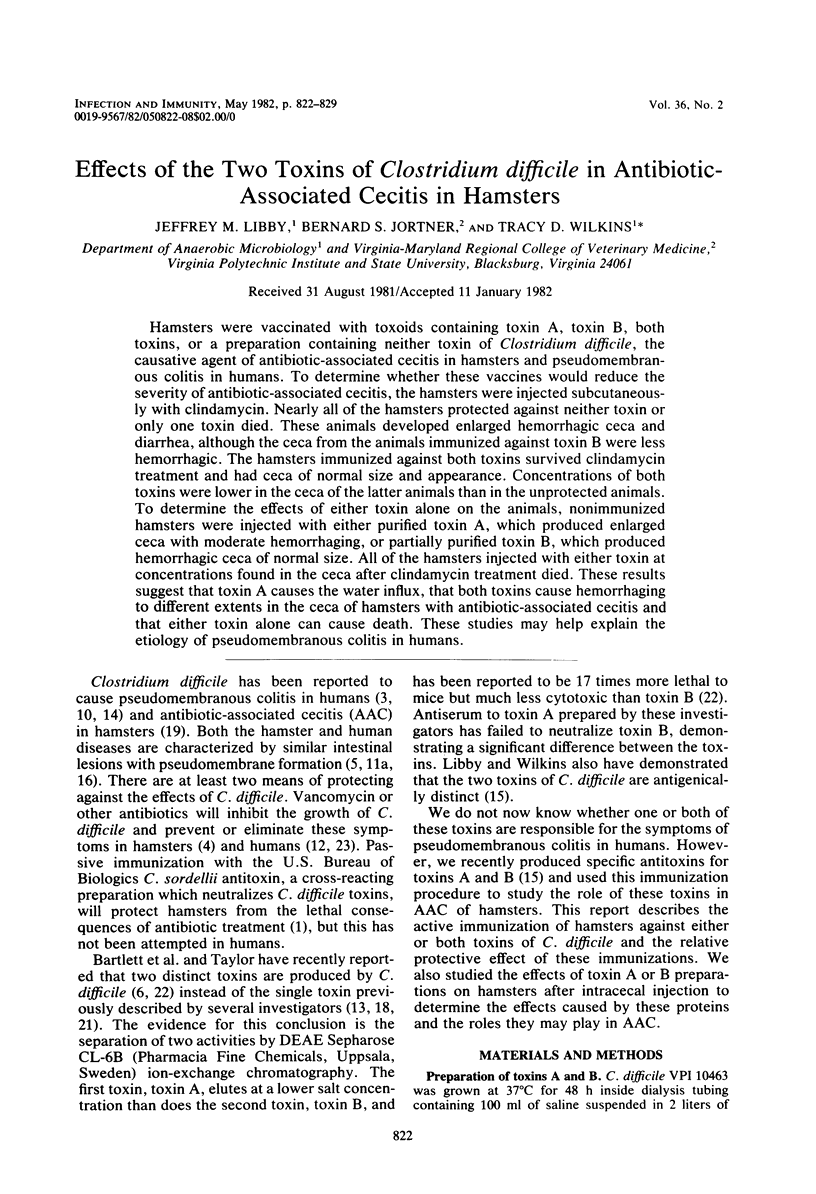
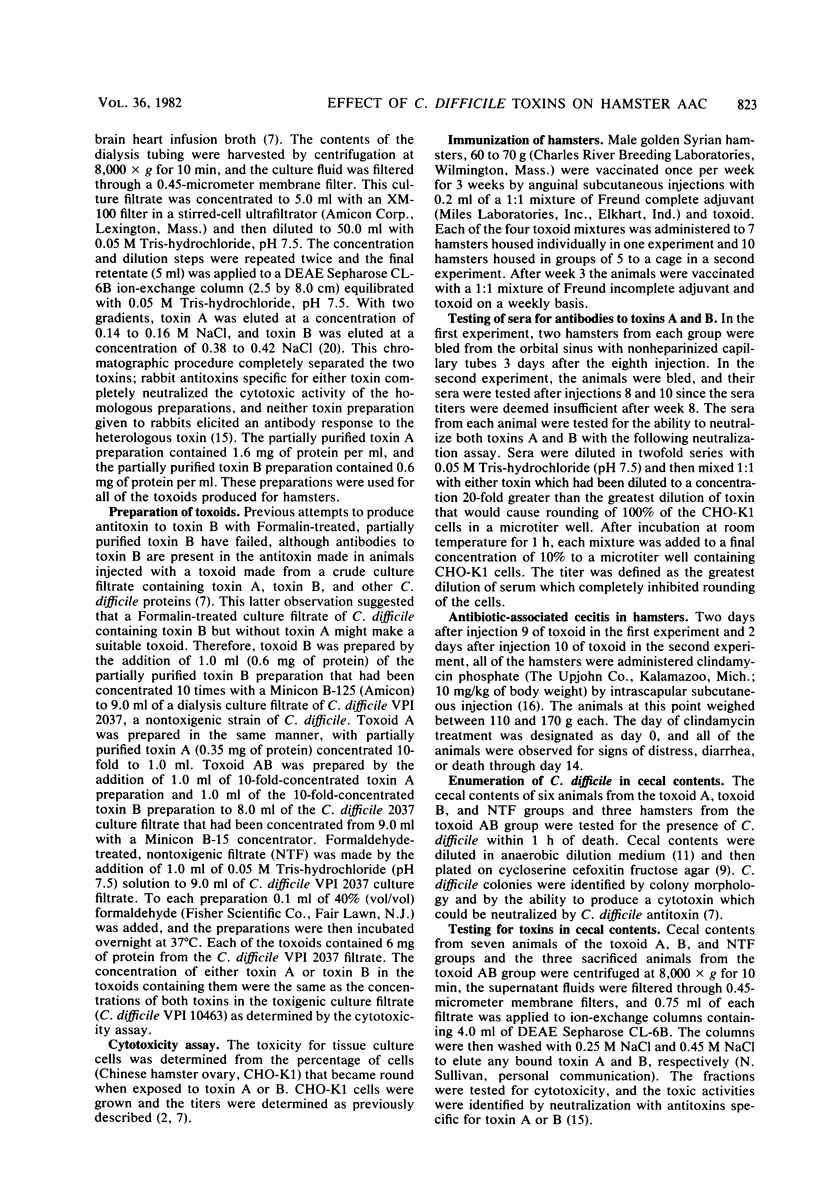
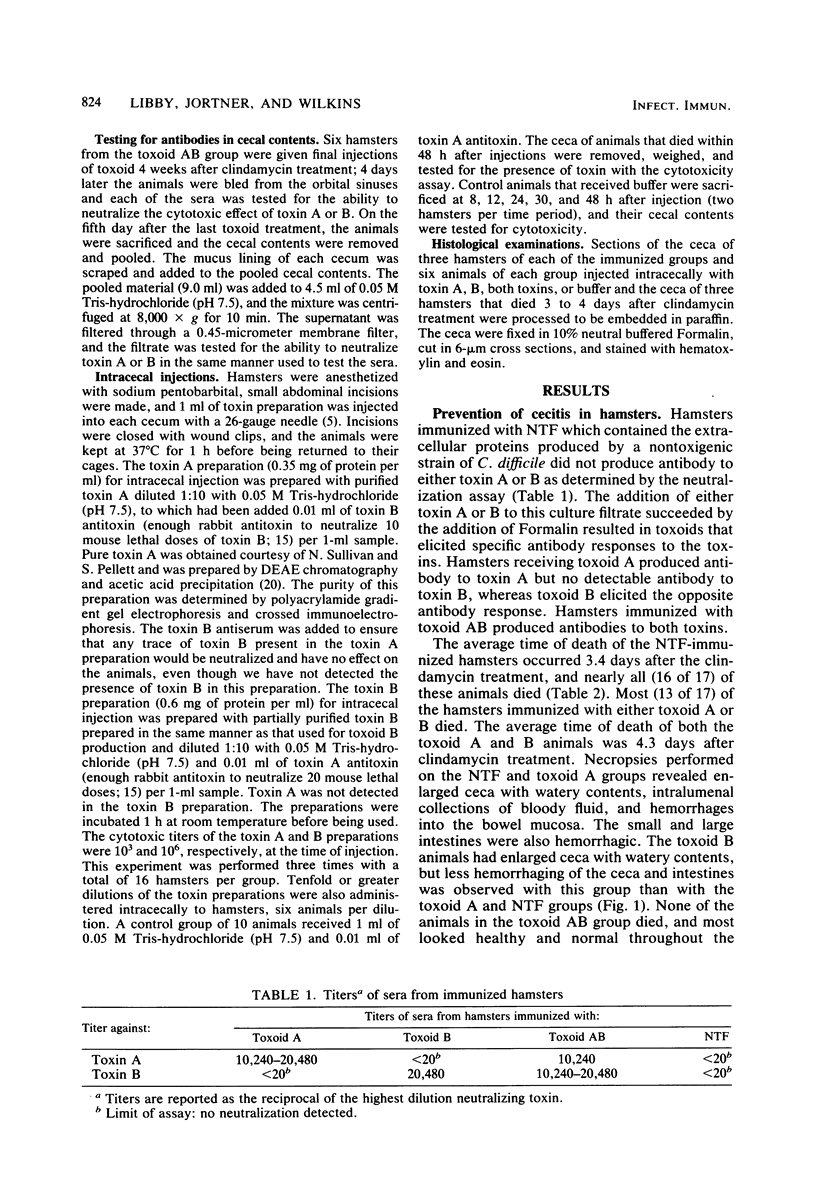
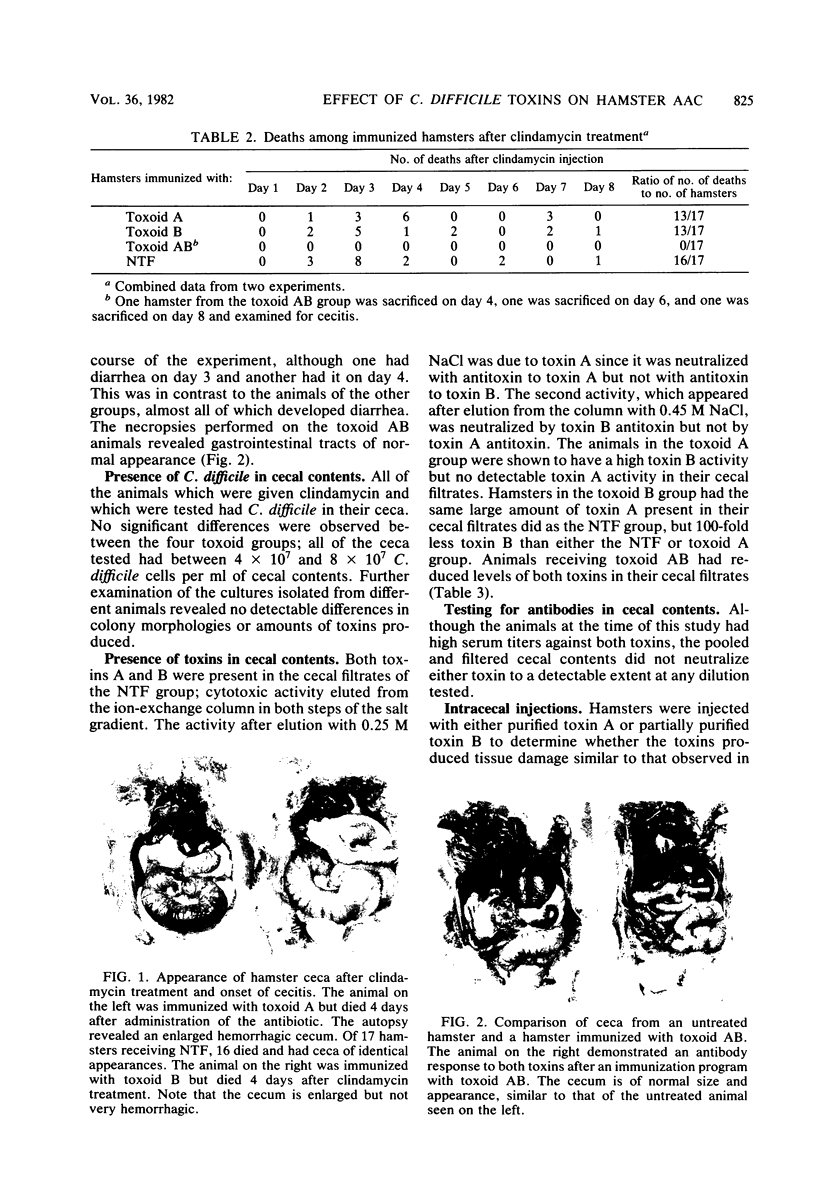
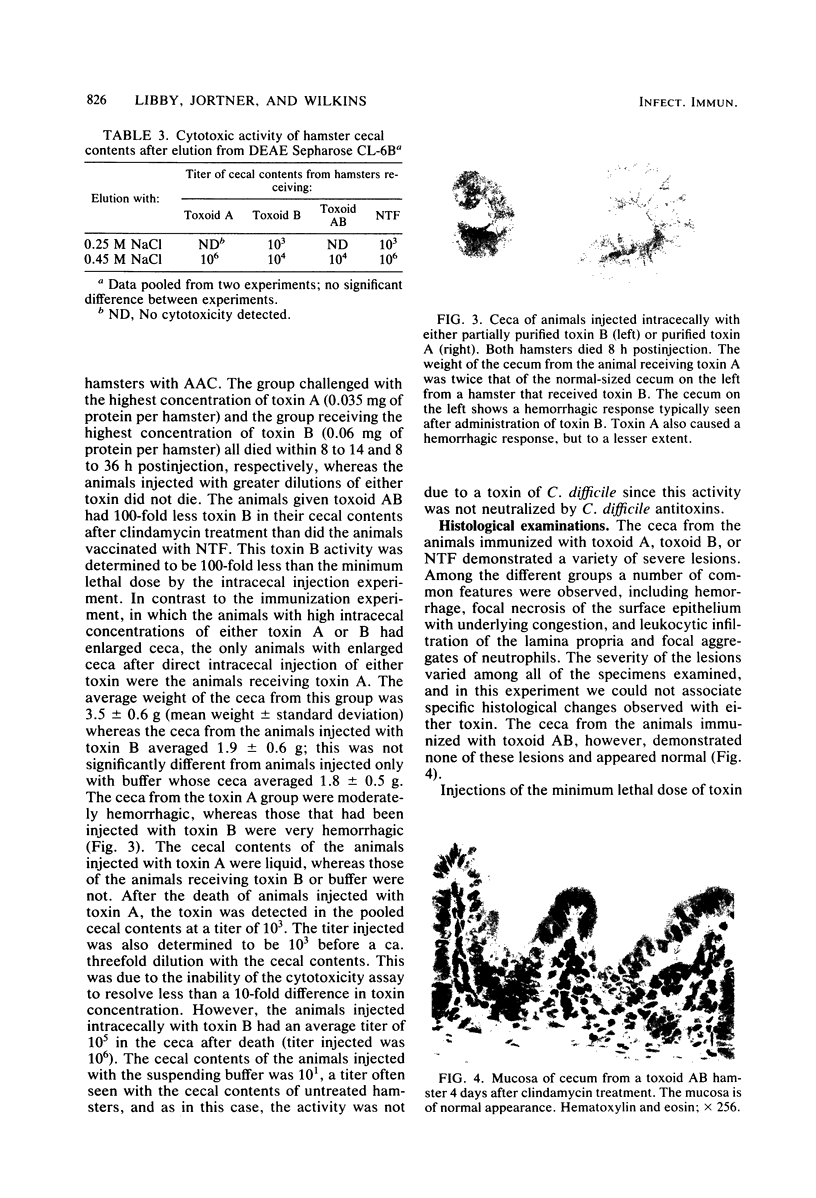
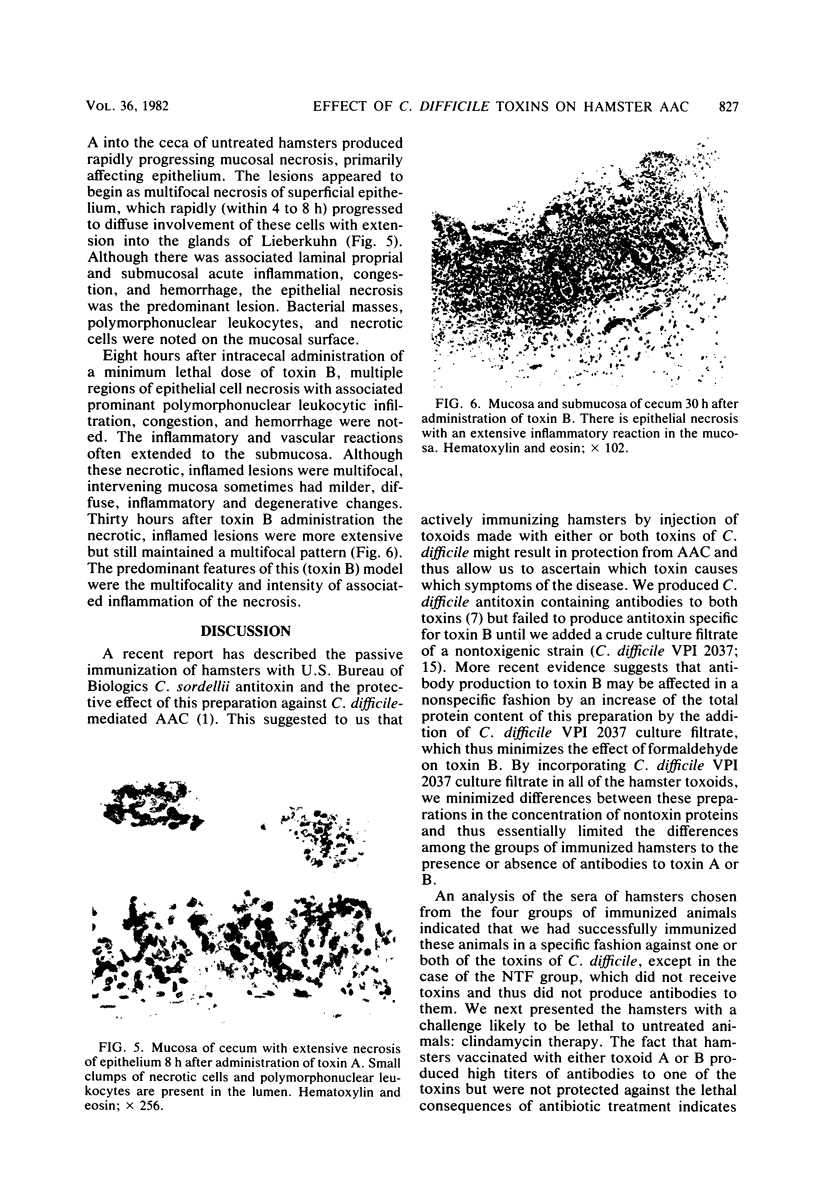
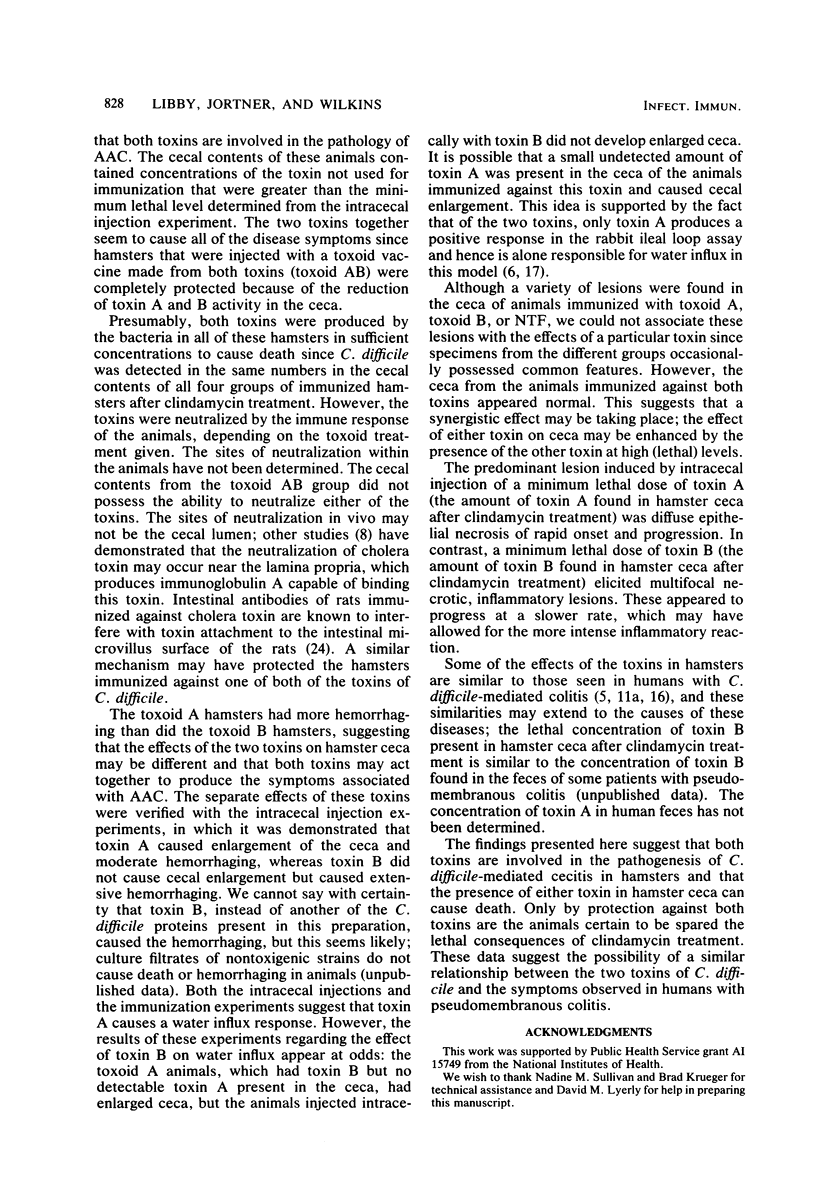
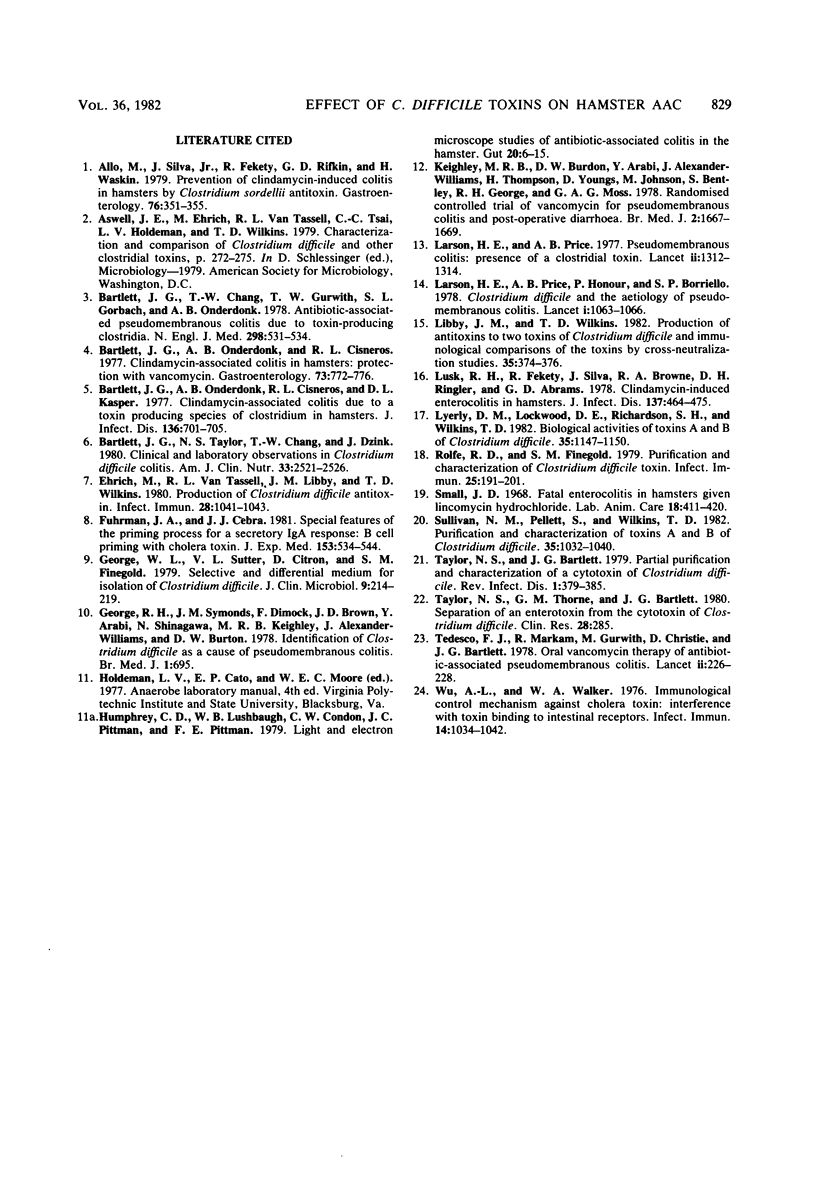
Images in this article
Selected References
These references are in PubMed. This may not be the complete list of references from this article.
- Allo M., Silva J., Jr, Fekety R., Rifkin G. D., Waskin H. Prevention of clindamycin-induced colitis in hamsters by Clostridium sordellii antitoxin. Gastroenterology. 1979 Feb;76(2):351–355. [PubMed] [Google Scholar]
- Bartlett J. G., Chang T. W., Gurwith M., Gorbach S. L., Onderdonk A. B. Antibiotic-associated pseudomembranous colitis due to toxin-producing clostridia. N Engl J Med. 1978 Mar 9;298(10):531–534. doi: 10.1056/NEJM197803092981003. [DOI] [PubMed] [Google Scholar]
- Bartlett J. G., Onderdonk A. B., Cisneros R. L. Clindamycin-associated colitis in hamsters: protection with vancomycin. Gastroenterology. 1977 Oct;73(4 Pt 1):772–776. [PubMed] [Google Scholar]
- Bartlett J. G., Onderdonk A. B., Cisneros R. L., Kasper D. L. Clindamycin-associated colitis due to a toxin-producing species of Clostridium in hamsters. J Infect Dis. 1977 Nov;136(5):701–705. doi: 10.1093/infdis/136.5.701. [DOI] [PubMed] [Google Scholar]
- Bartlett J. G., Taylor N. S., Chang T., Dzink J. Clinical and laboratory observations in Clostridium difficile colitis. Am J Clin Nutr. 1980 Nov;33(11 Suppl):2521–2526. doi: 10.1093/ajcn/33.11.2521. [DOI] [PubMed] [Google Scholar]
- Ehrich M., Van Tassell R. L., Libby J. M., Wilkins T. D. Production of Clostridium difficile antitoxin. Infect Immun. 1980 Jun;28(3):1041–1043. doi: 10.1128/iai.28.3.1041-1043.1980. [DOI] [PMC free article] [PubMed] [Google Scholar]
- Fuhrman J. A., Cebra J. J. Special features of the priming process for a secretory IgA response. B cell priming with cholera toxin. J Exp Med. 1981 Mar 1;153(3):534–544. doi: 10.1084/jem.153.3.534. [DOI] [PMC free article] [PubMed] [Google Scholar]
- George R. H., Symonds J. M., Dimock F., Brown J. D., Arabi Y., Shinagawa N., Keighley M. R., Alexander-Williams J., Burdon D. W. Identification of Clostridium difficile as a cause of pseudomembranous colitis. Br Med J. 1978 Mar 18;1(6114):695–695. doi: 10.1136/bmj.1.6114.695. [DOI] [PMC free article] [PubMed] [Google Scholar]
- George W. L., Sutter V. L., Citron D., Finegold S. M. Selective and differential medium for isolation of Clostridium difficile. J Clin Microbiol. 1979 Feb;9(2):214–219. doi: 10.1128/jcm.9.2.214-219.1979. [DOI] [PMC free article] [PubMed] [Google Scholar]
- Humphrey C. D., Lushbaugh W. B., Condon C. W., Pittman J. C., Pittman F. E. Light and electron microscopic studies of antibiotic associated colitis in the hamster. Gut. 1979 Jan;20(1):6–15. doi: 10.1136/gut.20.1.6. [DOI] [PMC free article] [PubMed] [Google Scholar]
- Keighley M. R., Burdon D. W., Arabi Y., Williams J. A., Thompson H., Youngs D., Johnson M., Bentley S., George R. H., Mogg G. A. Randomised controlled trial of vancomycin for pseudomembranous colitis and postoperative diarrhoea. Br Med J. 1978 Dec 16;2(6153):1667–1669. doi: 10.1136/bmj.2.6153.1667. [DOI] [PMC free article] [PubMed] [Google Scholar]
- Larson H. E., Price A. B., Honour P., Borriello S. P. Clostridium difficile and the aetiology of pseudomembranous colitis. Lancet. 1978 May 20;1(8073):1063–1066. doi: 10.1016/s0140-6736(78)90912-1. [DOI] [PubMed] [Google Scholar]
- Larson H. E., Price A. B. Pseudomembranous colitis: Presence of clostridial toxin. Lancet. 1977 Dec 24;2(8052-8053):1312–1314. doi: 10.1016/s0140-6736(77)90363-4. [DOI] [PubMed] [Google Scholar]
- Libby J. M., Wilkins T. D. Production of antitoxins to two toxins of Clostridium difficile and immunological comparison of the toxins by cross-neutralization studies. Infect Immun. 1982 Jan;35(1):374–376. doi: 10.1128/iai.35.1.374-376.1982. [DOI] [PMC free article] [PubMed] [Google Scholar]
- Lusk R. H., Fekety R., Silva J., Browne R. A., Ringler D. H., Abrams G. D. Clindamycin-induced enterocolitis in hamsters. J Infect Dis. 1978 Apr;137(4):464–475. doi: 10.1093/infdis/137.4.464. [DOI] [PubMed] [Google Scholar]
- Lyerly D. M., Lockwood D. E., Richardson S. H., Wilkins T. D. Biological activities of toxins A and B of Clostridium difficile. Infect Immun. 1982 Mar;35(3):1147–1150. doi: 10.1128/iai.35.3.1147-1150.1982. [DOI] [PMC free article] [PubMed] [Google Scholar]
- Rolfe R. D., Finegold S. M. Purification and characterization of Clostridium difficile toxin. Infect Immun. 1979 Jul;25(1):191–201. doi: 10.1128/iai.25.1.191-201.1979. [DOI] [PMC free article] [PubMed] [Google Scholar]
- Small J. D. Fatal enterocolitis in hamsters given lincomycin hydrochloride. Lab Anim Care. 1968 Aug;18(4):411–420. [PubMed] [Google Scholar]
- Sullivan N. M., Pellett S., Wilkins T. D. Purification and characterization of toxins A and B of Clostridium difficile. Infect Immun. 1982 Mar;35(3):1032–1040. doi: 10.1128/iai.35.3.1032-1040.1982. [DOI] [PMC free article] [PubMed] [Google Scholar]
- Taylor N. S., Bartlett J. G. Partial purification and characterization of a cytotoxin from Clostridium difficile. Rev Infect Dis. 1979 Mar-Apr;1(2):379–385. doi: 10.1093/clinids/1.2.379. [DOI] [PubMed] [Google Scholar]
- Tedesco F., Markham R., Gurwith M., Christie D., Bartlett J. G. Oral vancomycin for antibiotic-associated pseudomembranous colitis. Lancet. 1978 Jul 29;2(8083):226–228. doi: 10.1016/s0140-6736(78)91741-5. [DOI] [PubMed] [Google Scholar]
- Wu A. L., Walker W. A. Immunological control mechanism against cholera toxin: interference with toxin binding to intestinal receptors. Infect Immun. 1976 Oct;14(4):1034–1042. doi: 10.1128/iai.14.4.1034-1042.1976. [DOI] [PMC free article] [PubMed] [Google Scholar]








